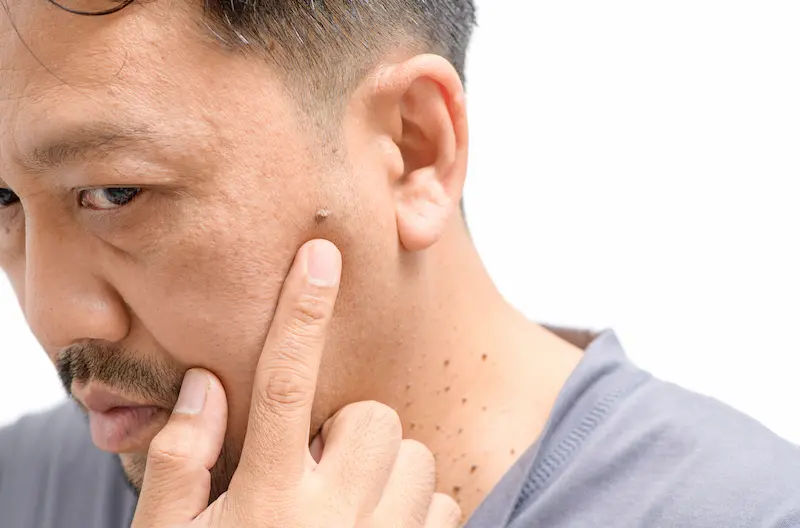Folliculitis: Causes, Symptoms, Treatment Strategies and Prevention
Folliculitis is a common inflammatory condition of the skin associated with hair follicles. Discover its types, causes, treatment, preventive tips, and dietary considerations to have a better understanding of the disease.

Written by
Last updated on 3rd Jul, 2025
Folliculitis is a widespread skin condition caused by inflamed hair follicles, which can occur anywhere on the body, including the palms and soles. It is often caused by a bacterial infection that can spread, leading to crusty sores. While mild folliculitis can be treated with self-care within a few days, severe or recurrent infections may require medical intervention.
Types of Folliculitis
There are different types of folliculitis depending on the location and cause, which are mentioned in the following section:
1. Pseudofolliculitis Barbae
Commonly known as ‘razor bumps,’ pseudofolliculitis barbae affects the beard area and is prevalent in black men. The trimmed edges can turn back in this condition, causing irritation and scarring.
2. Pseudomonas Aeruginosa or Hot Tub Folliculitis
This condition is caused by the bacteria Pseudomonas aeruginosa, which thrives in hot tubs, whirlpools, and water slides, where the water is heated and moving.
3. Malassezia Folliculitis
This type of folliculitis is caused by a family of yeast called Malassezia. It results in an itchy condition on the back and upper chest. Sweat is often seen to aggravate the condition.
4. Staphylococcus Aureus Folliculitis
In this type, the hair follicle gets infected with the bacteria Staphylococcus aureus. In mild cases, the infected area heals within a few days; in severe cases, the patient should seek medical help.
5. Sycosis Barbae
It is a severe and scarring form of folliculitis that results from shaving. In this condition, the entire hair follicle becomes infected, manifesting as red pustules. Individuals should avoid shaving in this condition.
6. Boils or Furuncles
When the hair follicle gets deeply infected, it results in boils or furuncles, which are often painful and tender. A head is formed after some days, leaving a scar behind.
7. Carbuncles
These occur as a result of infection of multiple hair follicles. In this, several boils are seen in one spot.
8. Gram-negative Folliculitis
This occurs when an individual is on prolonged acne-treating antibiotics. As a result, resistant bacteria grow and multiply over time, leading to gram-negative folliculitis.
9. Eosinophilic Folliculitis
This is a prevalent form of folliculitis in immunocompromised patients. It occurs in the upper arms, shoulders, neck, and forehead and improves on its own. However, it can recur.
Symptoms and Diagnosis of Folliculitis
Folliculitis is clinically manifested as small, crusty bumps or pustules that may look like acne in some conditions. These bumps can appear yellow, white, or red and are typically accompanied by itching or a burning sensation. In some instances, the bumps may be painful and tender to the touch.
The physician examines the inflamed areas and enquires about the following conditions:
The duration of the bumps
Any other associated symptoms
History of folliculitis, if any
The condition can be diagnosed through physical examination and inspection. However, a small sample may be taken to identify the causative agent.
Common Treatments for Folliculitis
Folliculitis is commonly treated with over-the-counter medications and prescription medicines, depending on the severity and type. The over-the-counter medicines include soothing lotion or a hydrocortisone cream having non-prescription strength.
The following are the prescription medications used to treat folliculitis:
Oral antibiotics, antibiotic gels, or lotions to control bacterial infection
Antifungal medications to treat folliculitis caused by yeast
Steroidal creams to calm inflammation
Home Remedies and Natural Treatment for Folliculitis
Mild folliculitis is often cured with proper self-care and home remedies. Some of the home remedies and natural treatments include:
A warm, moist washcloth should be applied to the affected area several times a day to relieve discomfort. The cloth can be moistened with a mixture of vinegar and water in the proper ratios.
The infected area should be gently cleaned with antibacterial soaps or cleansers, using a clean towel each time. Towels should be washed in hot water and not shared with others.
The affected area should be protected from injury, and shaving should be avoided if possible.
After proper cleaning, aloe vera gel should be applied to the infected area. This may help relieve redness, swelling, and itching. The gel should be free from added chemicals or perfumes.
Certain essential oils, such as cinnamon, lemon, clove, and eucalyptus, have antifungal and antibacterial properties that may aid in treating folliculitis. However, essential oils should be avoided during pregnancy or breastfeeding.
Lifestyle Changes to Prevent Folliculitis
Folliculitis can be prevented by changing lifestyle habits, which will limit the entry of infectious materials into the hair follicles. Individuals should
Keep the skin clean
Shave only when it is necessary
Check the disinfectant levels of hot tubs and pools
Remove the swimsuit and wash off after getting out of a hot tub
Wear breathable clothing
When to Consult a Dermatologist?
Mild cases of folliculitis are cured with home remedies and natural treatments. However, if the symptoms have aggravated or don’t go away after a week or two, one should consult a dermatologist. The aggravated symptoms include:
Fluid draining from bumps
Fever or chills
Painful or firm spots
Rashes spreading to other body parts
Consult Top Dermatologists For Folliculitis
Potential Complications from Untreated Folliculitis
Folliculitis, if left untreated, may result in certain complications that are listed below:
Hyperpigmentation or hypopigmentation of the affected areas
Permanent hair loss
Destruction of hair follicles
Recurrent infection
Understanding Treatment for Specific Types of Folliculitis
Once the physician identifies the cause of folliculitis, he may provide specific treatment for better recovery.
If the infection is caused by bacteria, the physician may prescribe antibiotic gels or lotions along with antiseptics to combat the infection. However, if the infection is serious, oral pills may also be prescribed.
Fungal folliculitis is cured with antifungal creams, shampoos, or pills.
Dietary and Nutritional Considerations to Manage Folliculitis
Nutrition and diet play a great role in healing inflammatory skin conditions. Antioxidant-containing foods such as berries, leafy greens, and turmeric, containing curcumin, help reduce oxidative stress and inflammation. Apart from these, dark chocolate and green tea are also known to reduce inflammation and improve skin health.
During the recovery, one should consume vitamin A-containing foods, such as carrots, sweet potatoes, etc., and silica-containing foods, like bell peppers and oats. These foods promote the production and repair of skin cells.
However, one should avoid excessive salty and spicy foods to prevent folliculitis flare-ups. Consumption of fermented foods and heavy proteins such as red meat are also known to increase inflammation and induce recurrence.
Future Trends in the Treatment of Folliculitis
Future trends in the treatment of folliculitis focus on using advanced technologies and personalised medicine approaches such as laser hair removal, targeted therapy, and photodynamic therapy.
Further studies are also conducted to develop more effective treatment regimens that limit the use of systemic antibiotics, reducing the potential side effects.
Conclusion
Folliculitis is a common yet manageable skin condition with various forms and causes, including bacterial and fungal infections. Early diagnosis and appropriate care are essential to prevent complications such as permanent hair loss, skin pigmentation changes, or recurrent infections.
By following preventive measures, seeking timely medical advice, and considering dietary and lifestyle changes, individuals can manage folliculitis effectively and reduce the risk of recurrence.
Consult Top Dermatologists
Consult Top Dermatologists For Folliculitis
Dr. Kavitha Killaparthy
Dermatologist
23 Years • MBBS,DIPLOMA(DERMATOLOGY,VENEREOLOGY,LEPROSY)
Hyderabad
JDS Skin & Hair Clinic, Hyderabad
Dr. Mayuri Jain
Dermatologist
11 Years • MBBS, MD Dermatology , Venereology & Leprosy
Delhi
Dr Mayuri Jain Clinic, Delhi

Dr Ekansh Shekhar
Dermatologist
10 Years • MBBS MD
Lucknow
Apollo Clinic Hazratganj, Lucknow
Dr.j Girishma
Dermatologist
6 Years • MBBS MD DERMATOLOGY
Bengaluru
Apollo Medical Center, Marathahalli, Bengaluru

Dr. Madhab Datta
Dermatologist
5 Years • MBBS, MD (DVL)
Kolkata
Dr. Madhab Datta's Clinic, Kolkata
Consult Top Dermatologists
Dr. Kavitha Killaparthy
Dermatologist
23 Years • MBBS,DIPLOMA(DERMATOLOGY,VENEREOLOGY,LEPROSY)
Hyderabad
JDS Skin & Hair Clinic, Hyderabad
Dr. Mayuri Jain
Dermatologist
11 Years • MBBS, MD Dermatology , Venereology & Leprosy
Delhi
Dr Mayuri Jain Clinic, Delhi

Dr Ekansh Shekhar
Dermatologist
10 Years • MBBS MD
Lucknow
Apollo Clinic Hazratganj, Lucknow
Dr.j Girishma
Dermatologist
6 Years • MBBS MD DERMATOLOGY
Bengaluru
Apollo Medical Center, Marathahalli, Bengaluru

Dr. Madhab Datta
Dermatologist
5 Years • MBBS, MD (DVL)
Kolkata
Dr. Madhab Datta's Clinic, Kolkata


